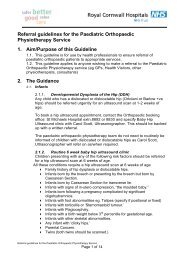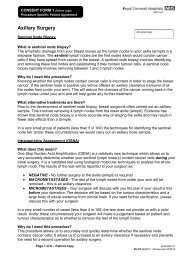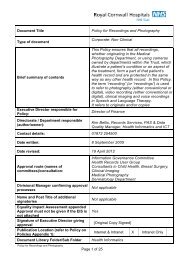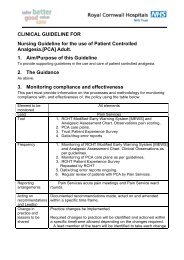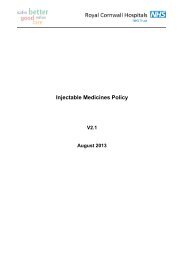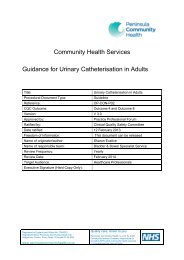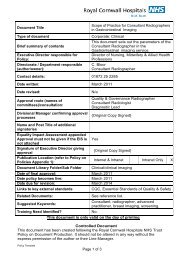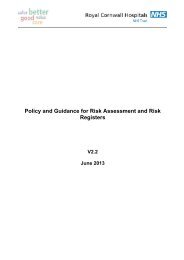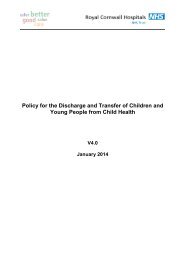(CVC) Management Guidance - the Royal Cornwall Hospitals Trust ...
(CVC) Management Guidance - the Royal Cornwall Hospitals Trust ...
(CVC) Management Guidance - the Royal Cornwall Hospitals Trust ...
You also want an ePaper? Increase the reach of your titles
YUMPU automatically turns print PDFs into web optimized ePapers that Google loves.
Standard Operating Procedure for Flushing Tunnelled Line (Hickman) <strong>CVC</strong> SOP2<br />
Procedure<br />
Equipment:<br />
Rationale<br />
To prepare for task<br />
Sterile dressing pack, Hand cleanser, Non sterile<br />
gloves, 10ml luer lock syringe, 10-20mls<br />
0.9%Sodium Chloride flush, 2% Chlorhexidine 70%<br />
Alcohol wipe x 2, sharps bin, secondary securing<br />
dressing, care plan, prescription chart<br />
1. Wash hands apply gloves and apron To reduce risk of cross contamination<br />
2. Prepare sterile field and equipment Advanced preparation for task and reduce risk of contamination<br />
3. Expose line and switch off any infusion and To allow easy access when sterile and reduce risk of infusion drips on sterile field. Note early signs<br />
observe VIP/CCAT score<br />
of phlebitis.<br />
4. Clamp line and using ANTT disconnect any Allow access to port and reduce risk of contamination<br />
infusion, seal giving set end with sterile Bung<br />
5. Remove gloves, wash hands and apply sterile Reduce risk of contamination<br />
gloves and apron.<br />
6. Prepare flush using sterile gauze to open flush Reduce risk of contamination and maintain sterile filed<br />
7. Using sterile gauze pick up clave end and clean Reduce risk of contamination<br />
with wipe for 30 seconds and allow drying for at<br />
least 30 seconds.<br />
8. Attach syringe using luer locking system<br />
unclamp line. Draw back if possible to test and<br />
using a push pause technique flush <strong>the</strong> line with<br />
10mls<br />
Maintain a closed system and keep line patent by creating turbulence in order to flush line<br />
thoroughly<br />
(if line contains Heparin, dispose of amount drawn back)<br />
9. Toward <strong>the</strong> last 1-2 mls clamp line but continue To lock <strong>the</strong> system under positive pressure reduce risk of backflow and clot formation<br />
to flush<br />
10. If Heparin is used, use only required amount To ensure line remains patent and Heparin is not used as a flush<br />
to lock e.g. 2-3mls<br />
11. Use second wipe to clean end as before Reduce risk of contamination<br />
12. Apply secondary dressing if required Comfort<br />
13. Dispose of all sharps and document action in Reduce risk of contamination to o<strong>the</strong>rs and maintain continuous records<br />
care plan<br />
*PHNT and <strong>Royal</strong> Marsden guidelines<br />
20 of 25




